Ketorolac + Moxifloxacin
Uses of Ketorolac + Moxifloxacin
Ketorolac + Moxifloxacin is primarily used in ophthalmology for managing inflammation, preventing infection after eye surgeries and treating various bacterial eye infections. This medicine belongs to the group of NSAIDs (non-steroidal anti-inflammatory drugs) and broad-spectrum antibiotics.
Secondary uses of this medicine include prophylaxis and reduction of inflammation and associated symptoms after cataract or refractive lens exchange surgery, treatment of bacterial conjunctivitis caused by susceptible strains, prevention of infection after corneal refractive surgery, and for managing inflammation and infection in corneal ulcers.
Side effects of Ketorolac + Moxifloxacin
Mild, transient burning, stinging and irritation upon instillation
Temporary blurred vision
Headache
Eye itching, redness, dryness and discomfort
Bitter taste
How Ketorolac + Moxifloxacin works
- Ketorolac + Moxifloxacin is a combination used in eye drops.
- Ketorolac is a non-steroidal anti-inflammatory drug (NSAID) that works by blocking the cyclooxygenase pathway, which plays a key role in producing prostaglandins. Prostaglandins are chemicals that cause inflammation and pain. By reducing the production of prostaglandins, Ketorolac alleviates inflammation and accompanying symptoms like pain and itching in ocular conditions.
- Moxifloxacin is a fluoroquinolone antibiotic. It stops bacterial growth by interfering with essential enzymes called DNA gyrase and topoisomerase IV. These enzymes are vital for bacterial DNA replication, transcription, repair, and recombination. By inhibiting these enzymes, Moxifloxacin prevents bacteria from multiplying and thus helps eliminate bacterial infections.
Certified content
Written By

BAMS, FMC, MD Resident
Reviewed By

Doctor of Medicine
Expert Advice
Dosage Forms Available
Ketorolac + Moxifloxacin is available for topical (single-vial sterile ophthalmic solution) use.
Age and Dose Restrictions
Ketorolac + Moxifloxacin is meant for adults.
Contraindications
Ketorolac + Moxifloxacin is contraindicated for patients with known allergy to either ketorolac, moxifloxacin, or any other NSAIDs or quinolone antibiotics. It should not be used by patients with epithelial herpes simplex keratitis, vaccinia, varicella, mycobacterial and fungal eye infections.
Other Medications to Avoid
Ketorolac + Moxifloxacin can interact with anti-coagulants (e.g., warfarin, heparin), SSRIs (e.g., fluoxetine, citalopram), antiplatelet agents (e.g., clopidogrel), Class IA and III antiarrhythmics (e.g., disopyramide, amiodarone), tricyclic antidepressants (e.g., imipramine) and other medicines that prolong the QT interval may have potential interaction with this combination.
Overdose and Missed Dose
In case you happen to put a few extra drops of Ketorolac + Moxifloxacin eye drops, do not panic. Rinse your eyes with clean water at room temperature. If any symptoms persist or worsen, inform your doctor.
For a missed dose, administer it as soon as you remember. If it is almost time for your next dose, skip the missed dose and continue with your regular schedule. Do not double the dose to make up for the missed one.
Management of Side Effects
Most side effects are temporary and generally harmless and resolve when discontinuing this medicine. However, if you experience any severe side effects or worsening of any of the symptoms, please consult your doctor.
For temporary blurred vision after administration, wait until your vision clears before doing any activities.
If eye itching, redness, dryness and discomfort occur, try rinsing your eyes with clean water at room temperature.
If a headache occurs, rest and relaxation may help. Avoid bright lights and reduce screen time.
Use in Driving and Operating Machinery
Ketorolac + Moxifloxacin may cause temporary blurred vision. It is advised to refrain from driving or operating heavy machinery until your vision is clear.
Use in Pregnancy and Lactation
Ketorolac + Moxifloxacin should be used with caution during pregnancy, particularly in the third trimester. It is advised to consult your doctor before using this medication combination.
Caution in Other Conditions
Patients with a history of recurrent corneal erosion syndrome should use this medication with caution as it may worsen the condition. Patients with known bleeding tendencies or those on anti-coagulants should use this medication cautiously as it may increase bleeding time.
Special Dietary and Lifestyle Recommendations
Maintain good hygiene to prevent re-infection or spread of the infection.
Avoid touching your eyes with dirty hands.
Protect your eyes from dust, smoke, pollen, and other irritants.
Rest your eyes frequently if you spend a lot of time reading or in front of screens.
Wear sunglasses to protect your eyes from excessive sunlight, which can cause inflammation and discomfort.
Frequently asked questions
Does Ketorolac + Moxifloxacin have any effect on sleep?
Ketorolac + Moxifloxacin is not known to have any effect on sleep. However, if you experience any unusual sleep patterns after using this medicine, you should consult your doctor.
Will Ketorolac + Moxifloxacin affect fertility?
Ketorolac + Moxifloxacin is not known to affect fertility. If you have concerns about fertility, it is advisable to consult your doctor.
Is it safe to take Ketorolac + Moxifloxacin daily?
It is safe to use Ketorolac + Moxifloxacin as recommended by your doctor. Do not self-medicate or change the dosage without consulting your doctor.
How much time does Ketorolac + Moxifloxacin take to work?
The time taken for Ketorolac + Moxifloxacin to work may vary based on the condition being managed and individual responses. Consult your doctor for detailed information.
What is the best time to take Ketorolac + Moxifloxacin?
The best time to use Ketorolac + Moxifloxacin is as recommended by your doctor. It is usually used at fixed intervals.
Can Ketorolac + Moxifloxacin affect my mood or emotions?
Ketorolac + Moxifloxacin does not have any known effect on mood or emotions. However, everyone responds to medication differently, so if you notice changes in your mood, consult your doctor.
Will the use of Ketorolac + Moxifloxacin affect my menstrual cycle?
Ketorolac + Moxifloxacin does not have any known effects on the menstrual cycle. If you notice changes during your menstrual cycle, consult your doctor.
Ketorolac + Moxifloxacin in other salts
List of Medicines for Ketorolac + Moxifloxacin
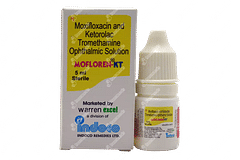
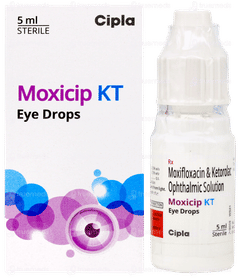
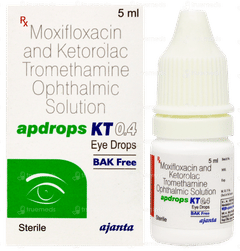
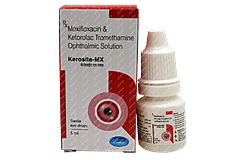
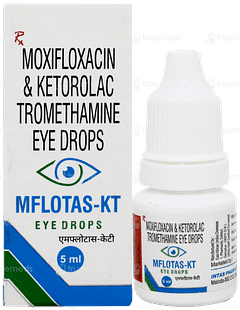
Company
About UsHealth ArticleHealth StoriesHealth LibraryDiseases & Health ConditionsAyurvedaAll MedicinesAll BrandsNeed HelpFAQSecuritySubscribe
Registered Office Address
Grievance Officer
Download Truemeds
Contact Us
Our customer representative team is available 7 days a week from 9 am - 9 pm.
v4.9.0
2025 - Truemeds | All rights reserved. Our content is for informational purposes only. See additional information.
Our Payment Partners










